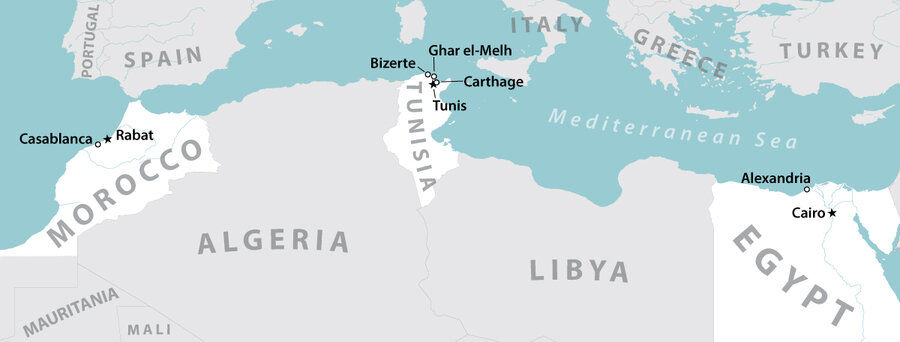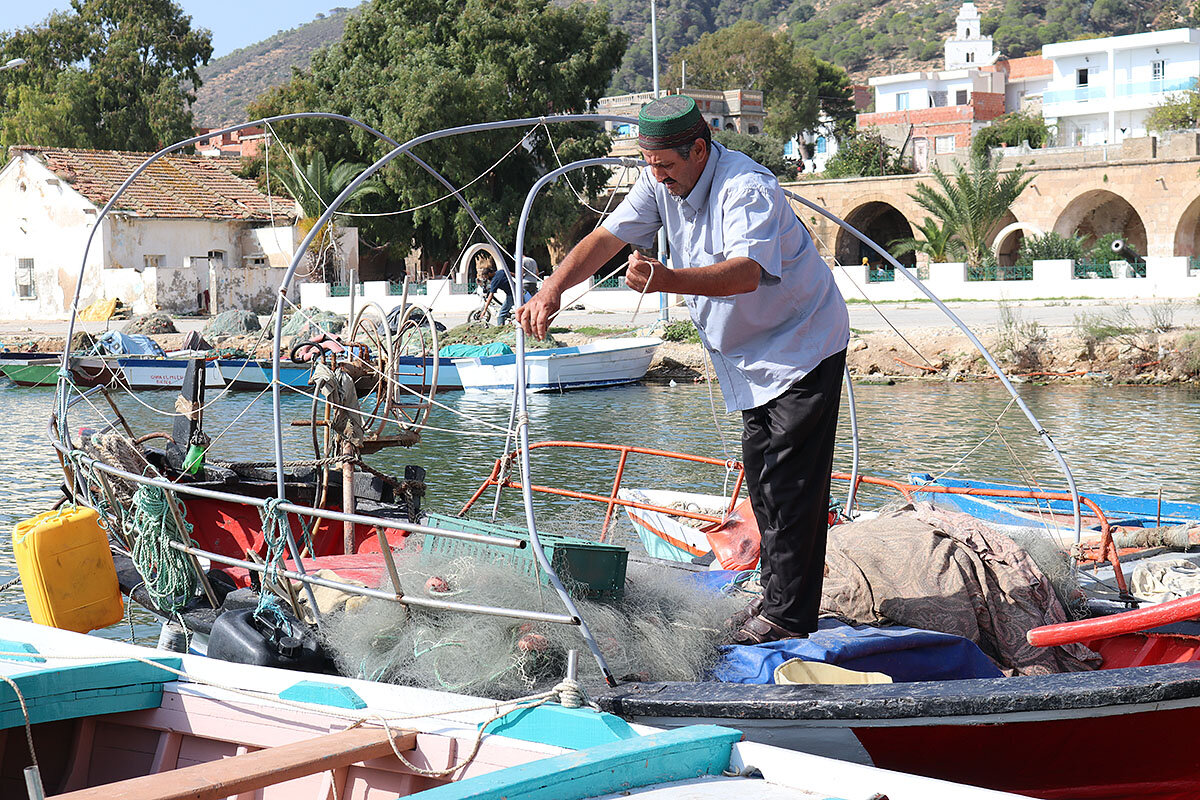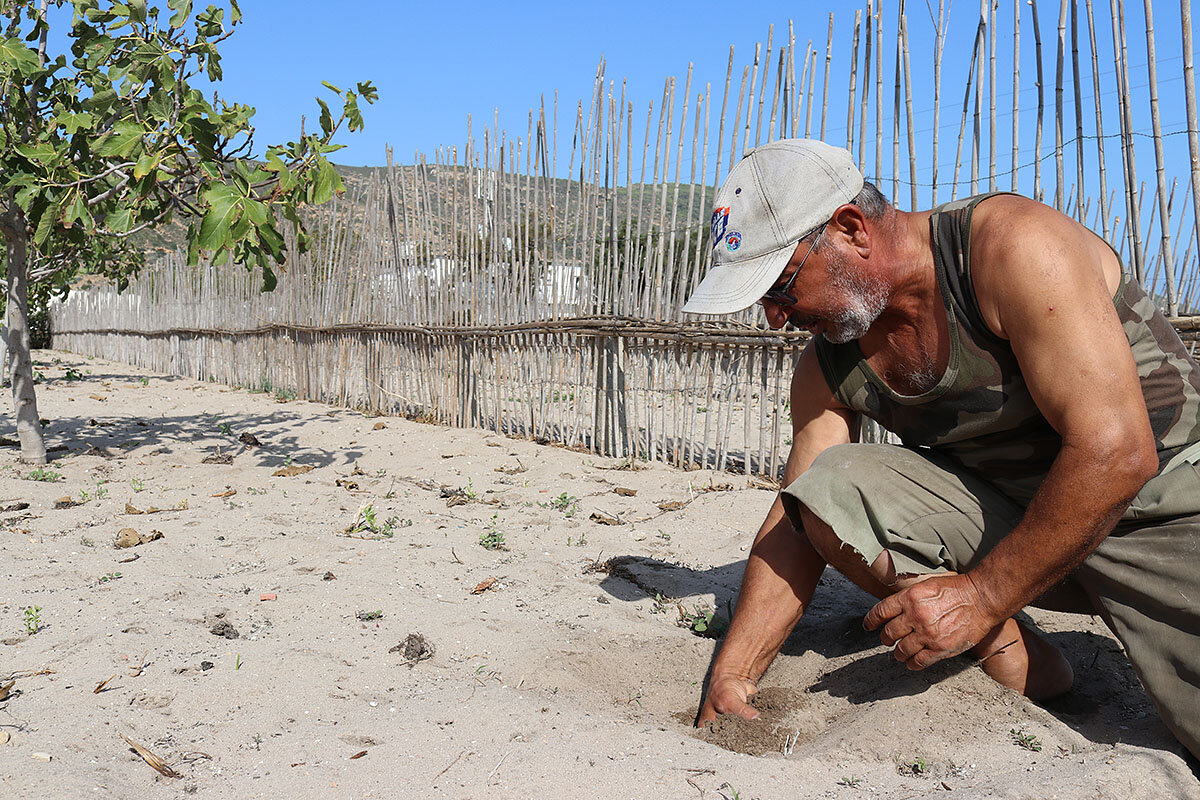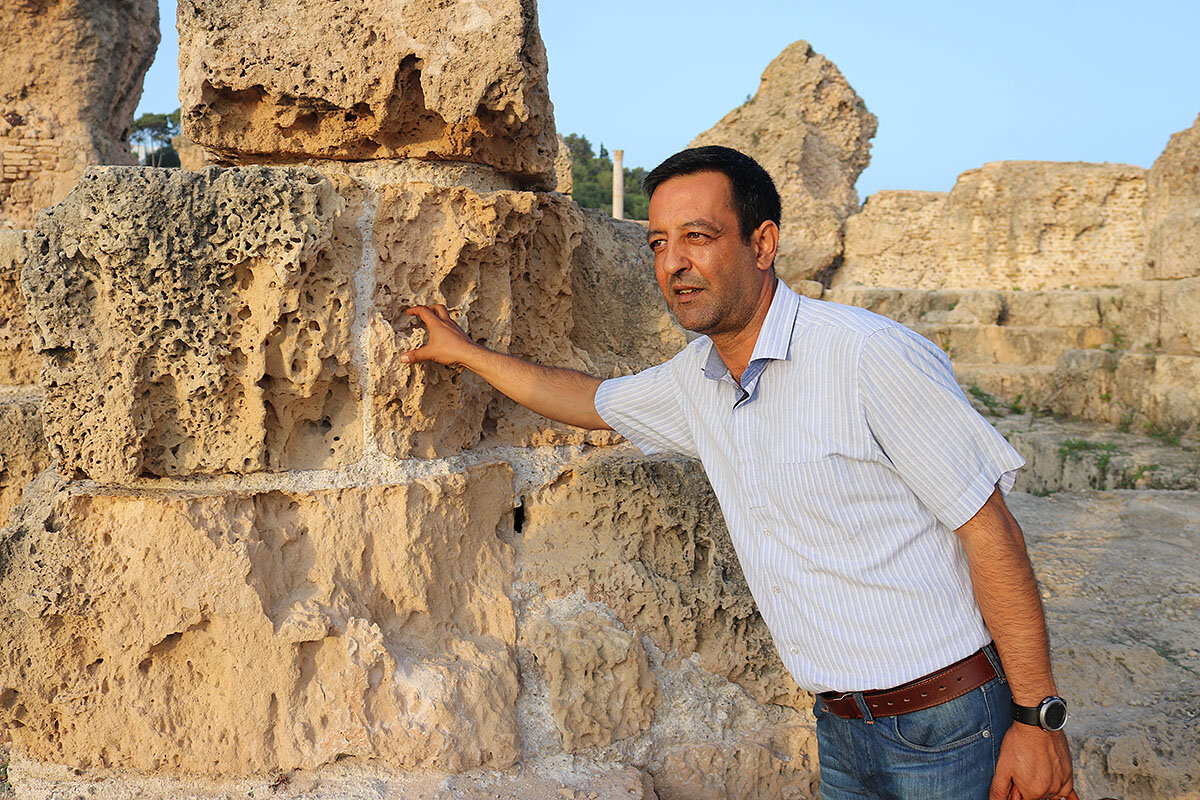Where climate change threatens ancient sites and modern livelihoods
| Carthage, Tunisia; and Casablanca, Morocco
Two thousand years after the Romans burned it to the ground, the ancient state of Carthage once again faces destruction – this time, from the sea.
Across North Africa, climate change is threatening heritage both ancient and modern as lives are being transformed across communities that date back centuries.
As it emerges on the front lines of the climate crisis, North Africa’s residents are racing to adapt with little support, resources, or attention.
Why We Wrote This
North Africa may not be front and center in the West’s discussion of climate change, but the challenges here are pressing – and lacking resources. This story is part of an occasional series on “Climate Realities.”
In Tunisia, the fishermen of Ghar el-Melh are where you can always find them these days – at the cafe down by the docks.
This town, 30 miles north of Tunis, the Tunisian capital, was once a bustling fishing hub, famous for its bountiful deep-water delicacies and freshwater species from the town’s lagoon.
But with warmer temperatures – and with it, higher winds and surging storms – the number of “fishing days” per year has dwindled from six months to just 60 days.
Instead, fishermen are resigned to the same routine: check the boats, unfurl the nets, and sit for hours in the cafe. Repeat.
As the fishermen sip espresso shots, they reminisce and list the names of big species that once thrived in the area that haven’t been seen for years: the Mediterranean sea bass, swordfish, octopus.
“Future generations here will only see these fish in the history books,” says captain Yas Bara, a fisherman of 44 years and the head of the local fishermen council.
Although 60 types of fish and crustaceans used to thrive in the area, residents now count 25. Marine specialists believe many of these species have left the area for deeper and colder waters as local sea temperatures have risen.
“This same time of year a few years ago we would be wearing winter coats, sweaters, and gloves,” Mr. Bara says, motioning to his T-shirt and shorts on this sunny day in late October.
But these changes are affecting more than just the sea.
With rising sea levels, the land barrier separating the ocean and the lagoon is rapidly receding. Only a couple of yards of land separate the sea from the 10-square-mile lagoon and its ecosystem of freshwater eels and fish.
“The coastline is becoming thinner each day,” says Mustapha Jebril, former mayor and environmental consultant, looking to the sea beyond. “The Mediterranean can cross into the lagoon any day and alter the ecosystem forever. We are one storm away.”
Should the lagoon be breached by rising seawater, up to 200 homes could be flooded, and a single storm could submerge the entire town.
Ghar el-Melh is a warning sign for Tunisia.
Due to its geographic position, this town historically served as the first line of defense for the rest of Tunisia; its capture was critical in the Romans’ campaign to Carthage.
Here, in the 16th century, Ottoman forces placed barracks and fortresses, and stationed 10,000 soldiers to prevent the Spanish Armada from reaching Tunis.
Now, these Ottoman defenses protect the Tunisian capital from rising sea levels.
Should the sea break the lagoon and submerge Ghar el-Melh, a major storm or flooding could submerge the lowlands all the way to Ariana, in the northwest suburbs of Tunis, destroying countless farms and properties along the way.
“These aren’t predictions,” Mr. Jebril says. “We have seen it happen.”
Farmlands on the front lines
Climate change has posed a particular challenge to North African farmers, many of whom have been using agricultural practices and techniques passed down through the generations dating back to the Spanish Inquisition.
Ali Garci’s farm near Bizerte, Tunisia, uses these techniques.
At his approximately 2-acre farm, a fence of reed shafts is carefully placed between the plots. The distance between each reed is the width of three fingers, allowing a temperate breeze to reach the crops but preventing heavy sea winds or sand-laden gusts from breaking or shattering the crops.
With his farm sitting only about 20 inches above sea level, he relies on cement pillars submerged some 2 feet deep into the water table to soak up salt from any potential seawater intrusion – another centuries-old technique.
Still, seawater has flooded the water table and wreaked havoc. The fig trees haven’t borne fruit in three years. In order to save his crop of fava beans, Mr. Garci is adding about 8 to 12 inches of soil to his farm on a regular basis to make sure roots do not drop into the rising water table. Yards of his farm’s northern edge have been reclaimed by the sea. Other Tunisian farms are dotted with sinkholes.
“My farm is disappearing,” says Mr. Garci, who retired from teaching to tend to his family farm.
While Tunisian farmers are battling to keep water out, farms in nearby Morocco are running dry.
With record-shattering temperatures and dwindling rainfall, Morocco has endured a series of record droughts over the past five years, devastating crops and the national economy.
Farmers have felt particularly vulnerable. More than 40% of Moroccans rely on farming, and more than 90% of farms are family-owned and measure less than about 12 acres.
For Azziz Hassine, drops in rainfall over the past two years have resulted in a 70% decrease in legume production on his 2 1/2 acre farm outside Casablanca.
“It is impossible to make a profit. My children will be worse off than I was,” says Mr. Hassine, who is battling both soil salinization and creeping desertification. “We don’t know what to do.”
“The farmers had local knowledge and could read seasons and know how and when to grow and how to prepare for drier years,” says Abderrahim Ksiri, a Moroccan environmental expert and leader of the Morocco Climate Change Alliance. “Now farmers in Morocco do not know when to plant and when to cultivate – or how.”
World heritage under threat
According to the Union for the Mediterranean (UfM), the temperature rise limit of 1.5 degrees Celsius set by the Paris accords has already been surpassed in the Mediterranean region. Under current trends – if climate policies worldwide are not altered – the region could see a 2.2 C rise in temperature within the next 20 years.
Across the Mediterranean, sea levels are already rising an average 3 millimeters per year. In some coastal areas, communities have seen as much as a 10-centimeter rise. Scientists and researchers working under the auspices of the UfM and European Union project that sea levels in North Africa could rise by 1 meter by 2100, affecting 16,000 square miles of coastline and displacing up to 37 million people.
Also endangered: the third-largest city-state of the ancient world.
Before the Punic Wars with Rome, Carthage was home to 300,000 people – and until recently, it was the most-visited archaeological site in Tunisia.
The site’s Punic Port, an island within a lagoon that was the site of the Third Punic War, is now eroding into the sea.
“That collapse over there just happened,” says Carthage site curator Moaz Achour, pointing to a cliffside of the port island that had recently crumbled into the lagoon. “And it is happening more and more frequently.”
The effects of a rapidly shifting climate are even more visible at Carthage’s seaside Antoninus Baths, the largest Roman baths outside mainland Italy.
Increased evaporation of seawater due to rising summer temperatures has led to high winds picking up salt, other minerals, and sand and slamming them into the seaside statues, columns, and monuments at a record pace.
With most of the monuments made from sandstone or limestone, these winds are dimpling and eroding away their Corinthian designs, like waves of tiny bullet holes in the rock.
UNESCO urged Tunisian authorities to come up with a strategy to better protect the site back in 2012, but due to the post-2011 revolution political upheaval, the Tunisian government was only able to turn its sights on Carthage last year.
Current intervention proposals include a stone-wall barrier to break the waves farther off the coast before they reach the site, while geological experts are developing protective coatings to place on monuments to help them withstand the increased weathering.
It is not just Carthage; 40 UNESCO World Heritage sites in the Mediterranean area are threatened by rising sea levels, 10 in North Africa. Hundreds of other archaeological sites are also threatened on North African coastlines.
“This is not just our national interests,” says Mr. Achour. “We must preserve these sites for humankind.”
Buying time
Few countries are working faster on climate change than Egypt; it has incorporated climate action into each ministry’s portfolio, built a 1,650-megawatt solar plant, and worked on a series of biofuel and waste management projects.
Egyptian authorities have built storm barriers to help save Alexandria and are even preparing 13 new urban centers near the Nile delta to relocate communities that could be affected by flooding.
But with the country just emerging from an economic crisis, it – like other North African states – is limited in what it can undertake.
“You cannot ask countries that are in economic transition and pursuing their development goals – especially here in North Africa – to fulfill their climate commitment when other parties did not fulfill theirs,” says Egypt Environment Minister Yasmine Fouad.
Perceived inequities in national climate commitments have been a major roadblock in hashing out a rulebook for the Paris climate agreement. The role of wealthy nations in funding energy transition and climate mitigation efforts in developing nations has been a particular sticking point. Efforts to codify such plans at the 2019 United Nations Climate Change Conference in Madrid failed.
A smattering of ad hoc programs is beginning to emerge in the absence of a coordinated global plan.
ClimaMed, a project launched by the UfM and EU, is working to link international financing to 100 climate-related projects across the Mediterranean area.
The UfM is also gathering money to establish a $250 million Mediterranean Area Climate Adaptation Fund to finance projects across the southern Mediterranean, where the threats are more urgent and resources at the state level are lacking.
The fund will support projects at the regional, city, and local levels, working directly with North African innovators and community leaders to tailor solutions to their community needs and make them financially feasible.
“If this fund works, the replicability and scalability of this initiative is limitless,” says Nasser Kamel, UfM secretary-general.
Until then, North Africans are left waiting – and scrambling for short-term solutions.
Owners of seaside restaurants and homes at the Sidi Ali El Mekki beach near Ghar el-Melh look on as teenage workers rush down the shoreline with sandbags over their shoulders to prop up against structures half-submerged by the encroaching sea.
“Sandbags won’t save the buildings; it is not a real solution,” says Oathman Ben Guara, municipal environmental adviser, shaking his head disapprovingly.
“But it buys them time.”










